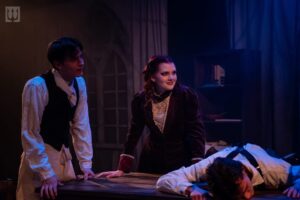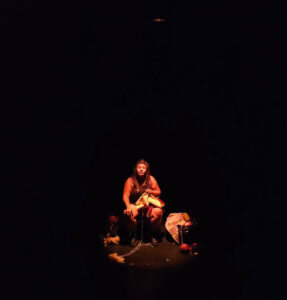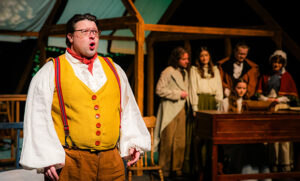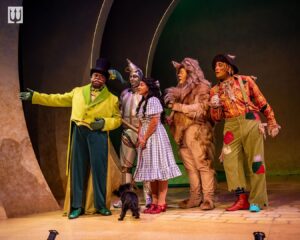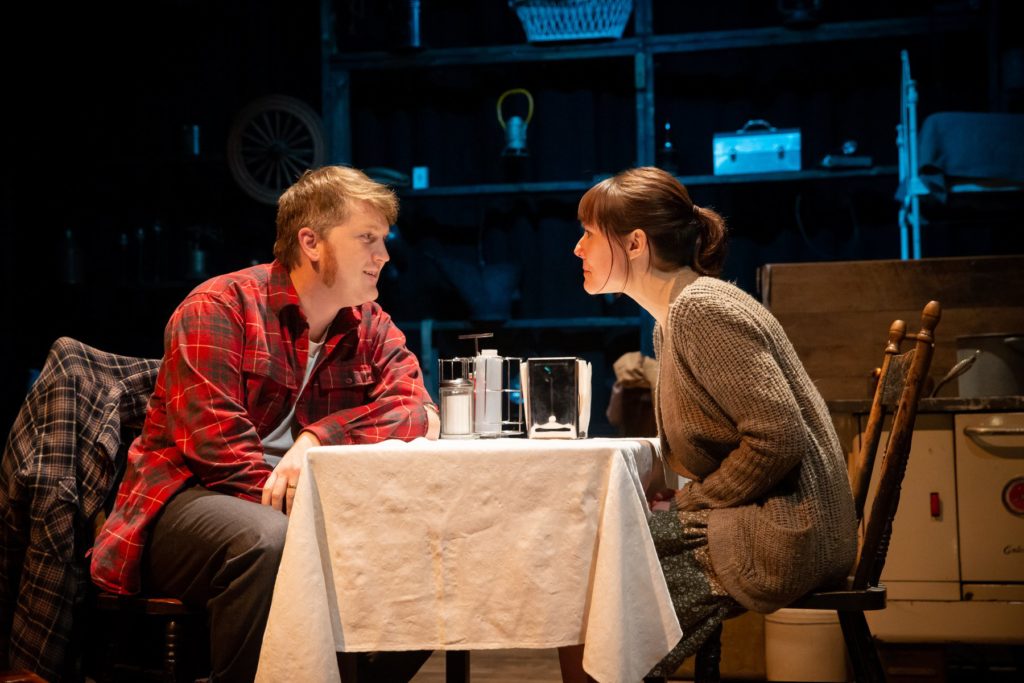
One of the most exciting recent developments in Nova Scotia theatre history is the addition of The Highland Arts Theatre (the HAT), which produces an astounding twelve-month season of professional theatre in downtown Sydney. Their most recent production, Wendy Lill’s The Glace Bay Miners’ Museum directed by Ron Jenkins, was the strongest production I’ve seen there yet.
The Glace Bay Miners’ Museum is set in Reserve Mines (the hometown of Sheldon Currie, who wrote the novel Lill’s play is based on) in the 1940s at the height of the mining industry there. Margaret MacNeil lives in a self-described shack with her mother, Catherine, her brother, Ian, and her grandfather, who has intense breathing issues and can no longer speak, caused by the decades’-long damage to his lungs from working in the mines. Margaret and Ian’s father and older brother, Charlie Dave, were killed in the same mining accident years before. Suddenly, Neil Currie bursts into their lives, speaking in Gaelic, playing the bagpipes, and encouraging the MacNeils to reject industry and reconnect with their ancestors and more traditional ways of living. The play paints a vivid picture of a community shackled to an unsustainable, toxic, industry that is killing them, but who face starvation, poverty and isolation if they dare to step out of line.
Dave Petrie plays Grandpa, whose connection with his family consists of writing down what he needs and then banging on something until someone pays attention to him. Kerrianne MacKenzie plays Catherine, exasperated, exhausted, and desperately wishing for a better life for her children. The arc for Petrie and MacKenzie is especially tender as Neil uses music, storytelling and a ball game to encourage the family to start really seeing, hearing and understanding one another. The pacing of these arcs is beautiful and we are able to see glimmers of what both Grandpa and Catherine were like in happier days. Brandon Carabin is Ian, a proud miner and proud union man who is trying to find the balance between realism and idealism. Carabin gives a lovely nuanced performance of a young man who is responsible and mature, who lives in the shadow of his older brother’s memory, who has strong convictions, but a sensitive heart, someone who needs to intervene when he sees an animal that is suffering- even if he’s not athletic enough to win the fight.
Mark Delaney plays Neil with rallying gusto. Delaney gives him a sort of abrasive, but endearing quality that works well showing how Neil both challenges and inspires the MacNeils to step outside their comfort zones, while simultaneously aggravating them in different ways. I appreciated the authentic way Delaney spoke and sang in Gaelic (it’s one of those things you just can’t fake, if Neil doesn’t sound like he’s really a Cape Bretoner it undermines the whole play), but I did wish that he was actually playing the bagpipes as well.
Jenna Lahey gives a phenomenal performance as Margaret. She has a difficult arc, going from a young socially awkward outcast with a prickly exterior, to a woman learning how to become more vulnerable and more comfortable expressing her thoughts and feelings, to someone who is knocked into emotional and psychological instability- all told from the perspective of Margaret at her most fragile. This is exacerbated by the fact that a lot of dramatic shifts are crammed into the end of Lill’s play, which makes it even more of a challenge for an actor to bring the audience along seamlessly for this journey. Lahey nails every moment, every nuance, every line. She is funny, she is heartbreaking, she is weird, she is frustrating, she is real.
Similarly, Ron Jenkins masterfully directs the piece with a beautiful sense of pacing, that allows the audience to make the leaps needed at the end of the play in order for it to be packed with a powerful punch. There’s a startling moment of tech- an assault of lighting and sound (Ken Heaton/Ciaran MacGillivray)- at the end of the play that is spectacular and I found myself moved to tears during the curtain call when Rita MacNeil’s voice came over the sound system with “Working Man.” You would think this choice would be way too on the nose, but, amazingly, it isn’t; it’s beautifully devastating, and the perfect ending for the piece.
It’s hard to believe that this is the first professional production of this show in Cape Breton. I think this is a definitive production of this play. Of course, acting is all about pretending, and that’s not to say that plays set in Cape Breton can’t be done well elsewhere, but there is an additional depth that just exists when you have actors and a creative team who understand exactly who these characters are because they intimately know the communities, the history, the nuance of the place where the story is set (and when you don’t have to worry at all about there being weird accents). I think this show is such a beautiful showcase of why The Highland Arts Theatre is so important for Sydney, and Cape Breton as a whole. Cape Breton has so many stories, and Cape Bretoners deserve to be able to tell these stories themselves, and also to see them come to life at home with such skill and artistry. The Glace Bay Miners’ Museum has been performed in theatres across the country for over two decades, I wish people from across the country had gotten the opportunity to see this production.
The Glace Bay Miners’ Museum closed on February 24th. The Highland Arts Theatre’s next show, See Jane Run, opens on March 12th. For more information please visit THIS WEBSITE or call 902.565.3637 or visit the Box Office at 40 Bentinck Street in Sydney.
You can follow The Highland Arts Theatre on Facebook. Twitter and Instagram (@highlandartstheatreofficial).

